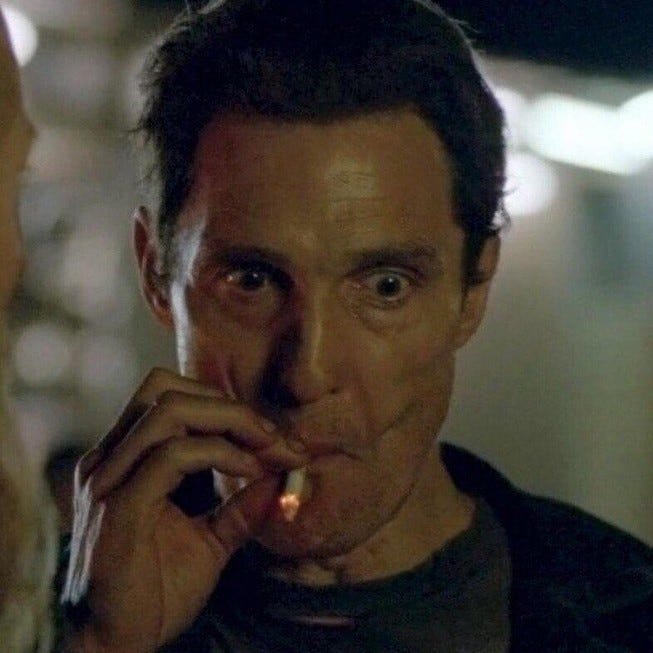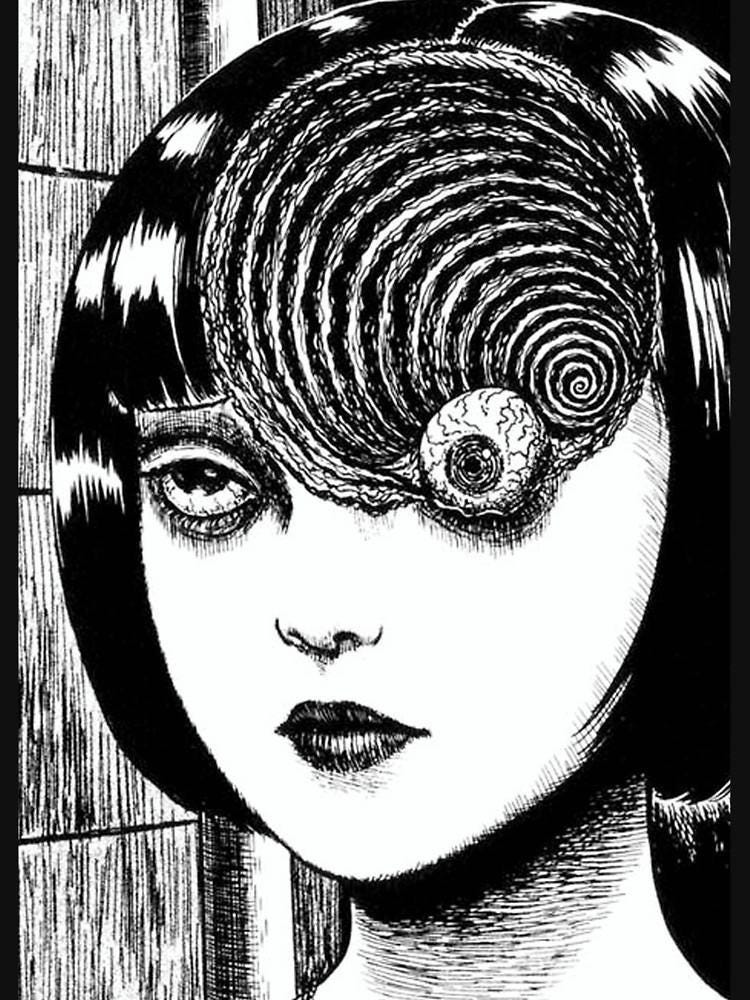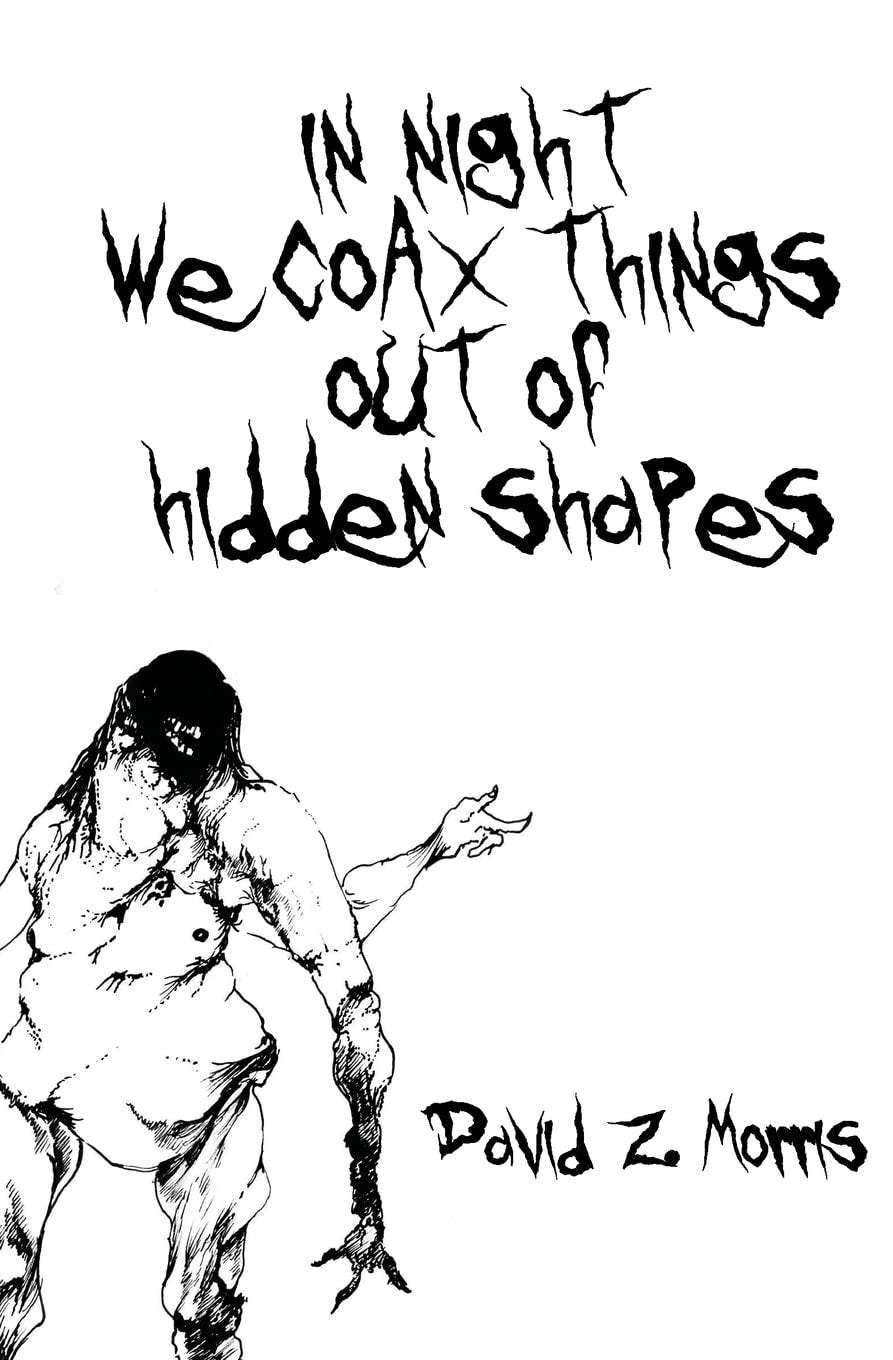Books that are Bad for your Soul
They’ll take you places. But they might not be places you want to go.
A change of pace this weekend: A guide to some of my very favorite books, each of them a real-world Necronomicon that will drive you from madness through to wisdom. Hopefully this is a preview of things to come as the newsletter covers more culture and art.
One small Sam Bankman-Fried update: Be sure to read the new piece by the Wall Street Journal’s Alexander Osipovich, which highlights the complicity of SBF’s parents in his election fraud.
***
tw: Cannibalism, Rot, Exploitation, Assault, Species Eliminationism, Bone Architecture, Misanthropy, Black Magic, Mutilation
Books Surveyed Within: Naked Lunch – William S. Burroughs (1959); Cyclonopedia: Complicity with Anonymous Materials – Reza Negarestani (2008); The Night Land – William Hope Hodgson (1912); Chaos – Tom O’Neil (2020); 300,000,000 – Blake Butler (2014); Terminal Park – Gary Shipley (2020); in night we coax things out of hidden shapes – David Z. Morris (2016); The Conspiracy Against the Human Race – Thomas Ligotti (2010); In the Dust of This Planet – Eugene Thacker (2011); There is No Antimemetics Division – qntm (2021); Fanged Noumena – Nick Land (2019)
Sam Bankman-Fried notoriously said he “would never read a book,” seemingly because he regarded them only as repositories of information, never as tools for thinking. Rejecting the depth and complexity of long-form writing is inevitably a turning away from the depth and complexity of human beings, and of the world. As I’ve recently written here, this is adjecent to the blindness of the Rationalists, the hole in the center of their faith that facts and deduction alone are the golden road to solving humanity’s problems.
That ignorance is double-edged. Without any deep awareness of the existence of darkness, ignorance, madness, and failure, self-regarding dingbats like SBF and Do Kwon can project a blind confidence that attracts fellow dimwits (and their money) in droves. But functionally, they carry the same virus of impulse, hunger, and frenzy – and their ignorance of their own nature robs them of any ability to act with foresight and nuance, leading them and their dimwit adherents to render down to the nothing they always were inside.
Of course, for both Sam and the Rationalists, the challenge is that they didn’t actually understand humanity’s real problem - the problem of the soul. In both cases, the most dangerous angle of this ignorance has been ignorance of their own complexity and weakness. Unchecked egotism, positivist epistemology, and a total incapacity for self-reflection seem to go three-in-hand.
What in fact exists within these people, though – the thing guarded from their own awareness so carefully – is the same howling darkness that we must each confront when we wake up in the morning. These and many other figures choose to turn away from the darkness, and are eventually, inevitably consumed by it.
The other option - thankfully, the natural inclination of most humans - is to examine the darkness, within and without, and try and grapple with it. The following is a list of books that, aesthetically, substantively, or both, face the darkness of humanity full-on.
They are journeys into night, from which you will return stronger - if with fewer comforting illusions.
Naked Lunch – William S. Burroughs (1959)
The original bringer of bad vibes.
William Burroughs was some kind of genius, and also a complete piece of shit, and when that’s done right, it’s maybe my favorite kind of artist. Burroughs was heir to an adding machine fortune (essentially, very early business computing), and as far as I know never actually worked a day in his life. Instead, he took heroin almost continuously, accidentally-on-purpose killed his wife (yes he was gay), probably did unspeakable things to young men in Tangiers – and wrote the best satire of America ever written.
Naked Lunch is mostly known as “hard to read” and partly that’s for formal reasons that apply to most of the following books. The trick is simple: just keep reading. These are mostly books that are meant to wash over you like unceasing waves, waiting for one or another detail to strike you in the head.
Of course, Naked Lunch is also hard to read because it includes things like tableaus of mass ritual executions conducted for the sexual gratification of alien lizards and government operatives. It is casually malevolent and randomly violent – just like the country it is meant to skewer. Terry Southern called it “an absolutely devastating ridicule of all that is false, primitive, and vicious in current American life.”
Cyclonopedia: Complicity with Anonymous Materials – Reza Negarestani (2008)
A book whose warning about evil is so convincing it vibrates with its own, answering darkness. The premise alone is haunting: Cyclonopedia posits that oil – petroleum, the black blood of the Earth – is actually a single conscious being that is cultivating humanity as a channel for its own transformation of the world to fulfill its own grim parameters. The book is nominally a kind of academic mystery, in which a handful of experts have discovered the secret of oil’s consciousness, and seek to warn the world. Of course, this is a horror novel, and also a novel about reality, so their warnings fail.
Negarestani was at least adjescent to Nick Land’s ccru collective, and this book channels the nihilistic speed-freak energy that Land cultivated. It’s vastly more focused and conceptually coherent than anything Land ever produced, but still shares the aesthetic of total fragmentation. The plot as such only emerges around the edges. An experience you must fully sink into.
The Night Land – William Hope Hodgson (1912)
Hodgson’s The House on the Borderland is more widely praised as a progenitor of modern horror, and you’ll figure out why once you’re about 200 pages into the droning repetition that is The Night Land. Its premise is bleak enough: it is the story of one sole human trapped on a dead, sunless planet, desperately navigating from one volcanic fault to another – these being the only sources of light and heat anywhere.
Again and again, he encounters nothing but vicious monsters and horrific situations, and it goes on and on and on. The linked edition runs to 359 pages. As an imaginative leap, for 1912, The Night Land is utterly unparalleled. But it also has effectively no plot, and while there’s nominally another human on screen and some gestures at two-dimensional romance, this is, spiritually speaking, a book that reproduces the experience of being completely alone, forever.
Chaos: Charles Manson, the C.I.A., and the Secret History of the Sixties – Tom O’Neil (2020)
While I’m focusing on fiction here, this book is the single factual document you need to absorb to understand why nihilism and paranoia are now the most honest subjects for art. The modern world was/is largely controlled by a cabal of state-connected American Fourth Reich psychopaths who seek to make us all subject to mind control experiments and mass delusion. O’Neil argues convincingly that, in addition to other forms of entrapment and enabling, the C.I.A.’s domestic operations were responsible for the creation of Charles Manson.
Relevant to the other topics of this newsletter, much of the human engineering funded and fostered by the CIA took place on or near the Stanford campus. For instance, “Psychiatrist” Louis Jolyon “Jolly” West, a.k.a. The American Mengele, spent most of his career posted at UCLA – but he conducted early experiments on indigent hippies at a public health clinic on San Francisco’s Haight-Ashberry.
300,000,000 – Blake Butler (2014)
Clearly inspired by the Manson cult, Blake Butler’s breakout novel is told largely from the perspective of an unrepentantly murderous cult leader and his drone-like punk-rock followers. Their goal is to kill the entire population of the United States – the 300 million people of the title.
The book’s descriptions of graphic and transgressive violence are, make no mistake, incredibly disturbing. Early sequences take place in a murder house to rival all others, where broken mirrors are pasted to floor and ceiling so that the killers can constantly witness the blood and suffering of their victims.
But what makes the book truly unnerving is that in that orgy of heartless destruction, Butler captures something timeless about a nation that is, after all, constantly trying to violently destroy itself from within.
The Orange Eats Creeps – Grace Krilanovich (2010)
Though less overtly malevolent than other books here, Krilanovich’s mythological tale of vampire street kids in Portland is suffused with a mood of almost impossibly dead-ender nihilism. It does involve things resembling “people” with vaguely realistic “feelings,” though, so it’s quite a bit less alienating than all these books about psychopathic mass murder. Maybe a good place to start your journey into the hole.
Sadly, Krilanovich has not published a second novel – yet. She’s brilliant.
Uzumaki - Junti Ito (2013)
It’s hard to pick the most nihilistic and haunting work of a guy who never gives his protagonists a win, but Uzumaki (“Spiral”) is probably his most defining work, the account of an entire community finding itself drawn inescapably into the void of obsession and selfishness.
And at its heart is a premise that is terrible simplicity itself. One by one, residents of a Japanese town (for a start) become inescapably enthralled by any and all spiral shapes. This includes brutal violence deployed in the collection of spiral objects, horrific bodily transformations in pursuit of looking like a spiral, etc. It’s a manga, and the illustrations are even more haunting than the premise.
Terminal Park – Gary Shipley (2020)
This is the book that inspired me to write this list - a new discovery that I’m still working my way through. It seems clearly ifluenced by Butler’s 300,000,000, but turns the experience from an intentionally endless and loveless slog into a short, sharp shock of demonic hate, with a bit more of a comprehensible plot.
The core concept is that, for reasons thus far unexplained, humans have started spontaneously reproducing clones of themselves at a random but rapid pace, leading to massive and uncontrollable human overpopulation. At the same time, for equally obscure reasons, humanity is hit by a wave of murderous and suicidal impulses, a re-ordering of morality itself shown through the wholesale uploading of live-streamed murder to platforms like YouTube. Quickly, though, the madness reaches such proportions that human corpses literally cover the Earth, in multiple layers, leaving only a few numb observers in the last high-rises standing.
in night we coax things out of hidden shapes – David Z. Morris (2016)
I can’t help a quick logroll here. This novella, written long ago, depicts one young alien’s futile attempt to rebel against a plantation system that readers will hopefully find familiar. Amidst strange creatures and bizarre rituals, he gets a hard lesson in the risks of cultural appropriation.
The Conspiracy Against the Human Race: A Contrivance of Horror – Thomas Ligotti (2010)
Next to Michel Houllebecq (who has an honorary place on this list), Ligotti has aspired to be the most misanthropic writer of the 21st century, a carrier-forward of Burroughs’ critique of modernism and efficiency, but also niceness and consumption, as the dead-ends that they are. Both this and Thacker’s survey (see below) are frequently referenced as inspirations of Nick Pizzolato’s True Detective, and specifically the nihilistic worldview of Rust Cohle.
Ligotti is a brilliant and admired writer of horror fiction, but this is a (seemingly) entirely sincere and invective-filled polemic in favor of philosophical nihilism, and of the quite literal voluntary self-elimination of humanity. Unironically only read this if you love life and want to glimpse into the void. Not for the faint of heart.
In the Dust of This Planet – Eugene Thacker (2011)
Along the same lines as “Conspiracy” but with a little more breathing room, Thacker’s work is more stylistically conventional as a work of philosophy (he’s a working academic), and could be said to explore nihilistic ideas, where Ligotti is actually advocating for them.
More elegantly, though, Thacker also lays out “horror” as an analytical approach, roughly to do with the exploration of the absolute inverse. His “Horror of Philosophy” series continued for three or four more books after this.
This is also a very short book, less than 100 pages if I remember correctly. Extremely worthwhile.
There is No Antimemetics Division – qntm (2021)
I’ve only just cracked the cover on this one, but wanted to include it for a specific reason: This novel is based in the “SCP Universe,” one of the most interesting experiments in collaborative fiction ever.
The SCP Universe is centered around one idea – a secret pseudo-governmental agency and its “Special Containment Protocols” for a seemingly endless catalog of supernatural, often malevolent objects and beings. Starting in roughly the mid-2000s, internet denizens could concoct their own SCP objects, with their own backstories and protocols, and post them on a wiki-like website that’s still around.
The setup has proven extremely fruitful for imagining the darkest of dark corners of the earth, the most evil and threatening secrets conceivable. This novel is about perhaps the scariest SCP ever concocted – an object, creature, or presence that erases all evidence of its own existence from the memory of anyone who learns about it.
Nick Land – Fanged Noumena (2019)
Like Carl Schmitt and William Burroughs before him, philosopher Nick Land is a terrible person who also happens to be right about a lot of things. While he has now turned entirely and unironically towards outright speed-freak fascism, his best collection largely consists of pre-2010 writing. That body of philosophical work on contemporary society, like the work of his inspirations Georges Bataille and Jacques Derrida, is a pursuit of nothingness, but not fully an embrace of nothingness.
And that, I think, is what makes most of these books worth reading. While dimwits will celebrate their depravity (as dimwits have celebrated Land’s), these are books about depicting the ultimate darkness so that we can more effectively turn away from the worst parts of ourselves.










I never commented on this substack post before as I thought it wouldn't have anything to do with crypto. But now I see it recommends "Chaos: Charles Manson, the C.I.A., and the Secret History of the Sixties – Tom O’Neil (2020)" which features prominently in the more conspiracy-like chapters of the SBF book that we've seen drafts of. And it's worth reading the reviews of that book. Mostly they are positive, but there are quite a few that say what is unfortunately often the case with these things--it's unsatisfying. If there was proof they wouldn't be theories. That said, here I am hoping that DZM will go into the possible Chinese money laundering / Tether thing in the book, which might also be unsatisfying.